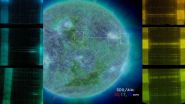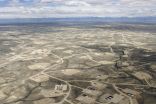INFORMATION:
Martin Struck, Christoff Andermann, Niels Hovius, Oliver Korup, Jens M. Turowski, Raj Bista, Hari P. Pandit and Ranjan K. Dahal: "Monsoonal hillslope processes determine grain size-specific suspended sediment fluxes in a trans-Himalayan river", Geophysical Research Letters, Vol. 42, Nr. 7, April 2015, pp. 2302-2308 DOI: 10.1002/2015GL063360
The cover photo of this GRL issue is a contribution tomthos article and was provided by Niels Hovius, GFZ German Research Centre for Geosciences
Photos in a printable resolution can be found here:
Fig. 1: High discharge and suspended sediment concentration during the second highest discharge event of the 2014 monsoon season, in the Kali Gandaki River at Tatopani in Nepal. photo: Christoff Andermann, GFZ
https://media.gfz-potsdam.de/gfz/wv/05_Medien_Kommunikation/Bildarchiv/_Einzelbilder_PM/suspended_fluxes_Tatopani.jpg
Fig. 2: Deepest gorge in the world during monsoon, the Kali Gandaki River in Nepal squeezes his way through a a vary narrow bedrock canyon on its way from the Tibetean Plateau (~5000 m asl.) down, through the High Himalayan mountain chain, to the Indian Lowlands (~100 m asl.). Photo: Christoff Andermann, GFZ
https://media.gfz-potsdam.de/gfz/wv/05_Medien_Kommunikation/Bildarchiv/_Einzelbilder_PM/deepest_gorge_world.jpg
Fig. 3: The Ganges delta seen from 11 000 m altitude. River sediments appears grey in the waters of the Indian Ocean. (photo: F.Ossing, GFZ)
https://media.gfz-potsdam.de/gfz/wv/05_Medien_Kommunikation/Bildarchiv/_Einzelbilder_PM/20150429_SedimentGanges.jpg
Erosion, landslides and monsoon across the Himalayas
2015-04-29
(Press-News.org) 29.04.2015: In these days, it was again tragically demonstrated that the Himalayas are one of the most active geodynamic regions of the world. Landslides belong to the most important geohazards. Besides earthquakes they are triggered mainly by strong rainfall events. A team of scientists from Nepal, Switzerland and Germany was now able to show how erosion processes caused by the monsoon are mirrored in the sediment load of a river crossing the Himalaya.
The geoscientists used data from two stations along the Kali Gandaki, a river that traverses the Himalaya from North to South through the deepest valley on Earth. The Kali Gandaki flows between the peaks of the Annapurna and Dhaulagiri, both reaching above 8000 m in height, and joins the Ganges in India. One of the stations is located at the transition from the Tibetan plateau and the high Himalayas, the other one lies in the middle Himalaya, south of the high peaks.
The size of particles transported transported by the river ranges from fine dust to boulders. Important information about erosion mechanisms in the river catchment can be obtained from these sizes, since they are determined by the rocks that are supplied from hillslopes and moved into the river by landsliding.
"For the first time we were able to obtain a time series of measurements from two different locations along a single river", says Christoff Andermann from the GFZ German Research Centre for Geosciences. "In this way we can differentiate between sediments: which material came from Tibet and were transported through the Himalaya, and which were produced in the Himalayas themselves?" The key to the answer for these questions lies in the size of the transported particles, the grain size.
Although the Tibetan material always shows the same size, the Himalayan sediment is bigger during the summer monsoon. GFZ scientist Andermann: "The comparison with the timing of landslides shows the relationship between the erosion of the mountains and the monsoon, since most landslides are caused by heavy rain."
The study raises interesting questions about geo-archives: the erosional history of mountains can be reconstructed from their deposits. However, sediments in the Gulf of Bengal, commonly associated with the Himalaya, contain mainly fine material. The coarse material of the Himalaya seem to have been lost somewhere on the way to the ocean. Thus, the question arises where the sediments in the Gulf of Bengal originated from and what stories they can tell.
ELSE PRESS RELEASES FROM THIS DATE:
Making robots more human
2015-04-29
Most people are naturally adept at reading facial expressions -- from smiling and frowning to brow-furrowing and eye-rolling -- to tell what others are feeling. Now scientists have developed ultra-sensitive, wearable sensors that can do the same thing. Their technology, reported in the journal ACS Nano, could help robot developers make their machines more human.
Nae-Eung Lee and colleagues note that one way to make interactions between people and robots more intuitive would be to endow machines with the ability to read their users' emotions and respond with a computer ...
Science Academies hand over statements for G7 summit to German Chancellor Merkel
2015-04-29
Today the national science academies of the G7 countries handed three statements to their respective heads of government for discussion during the G7 summit at Schloss Elmau in early June 2015. The papers on antibiotic resistance, neglected and poverty-related diseases, and the future of the ocean were drawn up by the seven national academies under the aegis of the German National Academy of Sciences Leopoldina.
The G7 academies call for a comprehensive strategy to tackle health threats from infectious diseases; progress toward preventing, controlling and eliminating ...
Enron becomes unlikely data source for computer science researchers
2015-04-29
Computer science researchers have turned to unlikely sources - including Enron - for assembling huge collections of spreadsheets that can be used to study how people use this software. The goal is for the data to facilitate research to make spreadsheets more useful.
"We study spreadsheets because spreadsheet software is used to track everything from corporate earnings to employee benefits, and even simple errors can cost organizations millions of dollars," says Emerson Murphy-Hill, an assistant professor of computer science at NC State and co-author of two new papers ...
Drug resistant bacteria common for nursing home residents with dementia
2015-04-29
NEW YORK (April 29, 2015) - A new study found one in five nursing home residents with advanced dementia harbor strains of drug-resistant bacteria and more than 10 percent of the drug-resistant bacteria are resistant to four or more antibiotic classes. The research was published online today in Infection Control & Hospital Epidemiology, the journal of the Society for Healthcare Epidemiology of America.
"Nursing home residents with advanced dementia usually have an increased need for healthcare worker assistance, as well as frequent exposure to antibiotics. This combination ...
Stem cell transplantation for multiple myeloma: New data did not change conclusion
2015-04-29
An update search enlarged the pool of study data, but did not change the content of the conclusion of the benefit assessment of stem cell transplantation (SCT) for multiple myeloma conducted in 2012. Overall, the evidence base remained insufficient: Until now, data on quality of life have not been recorded in any study at all. And three large studies, some of which were under German management, have not been completely published even more than 10 years after their completion. This is the conclusion of a rapid report published by the Institute for Quality and Efficiency ...
Shrinking budget? Consumers choose less variety when investing or shopping
2015-04-29
When consumer budgets grow or shrink, how do spending habits change? A common view is that people with a budget will spend their money on the same number of products, even when their previous budget was lower or higher. But in order to keep their favorite items, consumers whose budgets have shrunk to a particular amount will opt for less variety than someone whose budget has increased to that same amount, according to a new study in the Journal of Marketing Research. Investors beware!
"We call this the budget contraction effect," write authors Kurt A. Carlson (Georgetown ...
The victimization quandry: To help victims we have to stop blaming them
2015-04-29
(NEWARK, NJ) - April 29, 2014 - A woman is brutally assaulted, but rather than receiving the sympathy she deserves, she is blamed. If she had dressed differently or acted differently, or made wiser choices, others say, she would have been spared her ordeal. For victims, this "victim blaming" is profoundly hurtful, and can lead to secondary victimization.
Psychologists have long realized that blaming victims is a defense mechanism that helps blamers feel better about the world, and see it as fair and just. But ways to prevent victim blaming have been elusive -- until ...
Strong evidence for coronal heating theory presented at 2015 TESS meeting
2015-04-29
The sun's surface is blisteringly hot at 10,340 degrees Fahrenheit -- but its atmosphere is another 300 times hotter. This has led to an enduring mystery for those who study the sun: What heats the atmosphere to such extreme temperatures? Normally when you move away from a hot source the environment gets cooler, but some mechanism is clearly at work in the solar atmosphere, the corona, to bring the temperatures up so high.
Clear evidence now suggests that the heating mechanism depends on regular, but intermittent explosive bursts of heat, rather than on continuous gradual ...
UM study: Oil and gas development transforms landscapes
2015-04-29
MISSOULA - Improved drilling technologies and energy demand have resulted in the large-scale expansion of oil and gas development, with 50,000 new wells drilled per year recently in central North America. Locations such as the Bakken, Eagle Ford and the Marcellus Shale are now commonplace, and drilling activity frequently makes news.
But what are the ecological consequences of this accelerated drilling activity? Researchers at the University of Montana have conducted the first-ever broad-scale scientific assessment of how oil and gas development transforms landscapes ...
Study finds ancient clam beaches not so natural
2015-04-29
Casting a large interdisciplinary research net has helped Simon Fraser University archaeologist Dana Lepofsky and 10 collaborators dig deeper into their findings about ancient clam gardens in the Pacific Northwest to formulate new perspectives.
Lepofsky's research team has discovered that Northwest Coast Indigenous people didn't make their living just by gathering the natural ocean's bounty. Rather, from Alaska to Washington, they were farmers who cultivated productive clam gardens to ensure abundant and sustainable clam harvests.
In its new paper published by American ...

